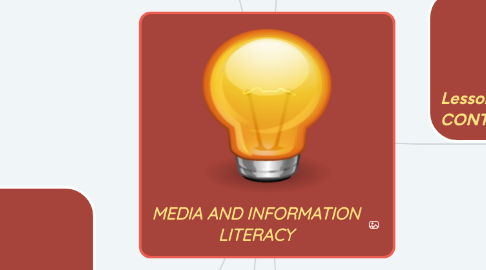
1. Lesson 2 UNDERSTANDING MEDIA: AESTHETICS OF THE IMAGE, TEXT, AND AUDIO
1.1. Framing and Reading
1.1.1. Newspapers and Journalism
1.1.2. Books, Comics, Magazines, and the Publishing Industry
1.1.3. Photography and Timeless Image Concepts
1.2. Framing and Listening
1.2.1. Radio and Evoking Imagination
2. UNIT II Lesson 1 PROS AND CONS: IMAGE, TEXT, AND AUDIO
2.1. Text-specific Issues
2.1.1. Image-specific Issues
2.1.1.1. Image Manipulation
2.1.1.2. Image Grabbing and Plagiarism
2.1.2. Original Words and Plagiarism
2.1.3. News and Biases
2.1.4. Newspapers and Media Control
2.1.5. The So-called "Fake News" Phenomenon
2.1.5.1. Misinformation
2.1.5.2. Disinformation
2.1.5.3. Mal-Information
2.1.5.4. 7 common types of misinformation and disinformation rampant in today's news media world, especially as seen on social media.
2.1.5.4.1. Satire or parody
2.1.5.4.2. Misleading content
2.1.5.4.3. Imposer content
2.1.5.4.4. Fabricated content
2.1.5.4.5. False connection
2.1.5.4.6. False context
2.1.5.4.7. Manipulated content
2.2. Audio-specific Issues
2.2.1. Radio and Its Effect
2.2.2. Music and Its Effect
3. Lesson 1: MEDIA IN THE CONTEXT OF MIL
3.1. The study of media and information literacy (MIL) basically focuses on how human communication processes are greatly affected by media and information.
3.2. The United Nations Educational, Scientific, and Cultural Organization (UNESCO)
3.2.1. Encourages, facilitates, and monitors the development of media and information literacy in the world.
3.3. What to Expect in Your MIL Course
3.3.1. We're not only learning about the nature of media in relation to other fields, but we are also learning about how to be literate when we deal with various media channels.
3.4. MIL Thematic Coverage
3.4.1. Differentiating Media Literacy (MIL) and Information Literacy
3.4.1.1. Media Literacy focuses on the media for good democracy and development.
3.4.1.2. Information Literacy is concerned with how data and information in any format and form are managed, using different technological tools.
3.4.2. Media and Information Sources
3.4.3. Media and Information Languages
3.4.4. Literacies of the 21st Century
3.5. UNESCO 5 Laws of Media Literacy
3.5.1. Law 1: Information, communication libraries, media, technology, the Internet as well as other forms of information providers are for use in critical civic engagement and sustainable development.
3.5.2. Law 2: Every citizen is a creator of information/knowledge and has a message.
3.5.3. Law 3: Information, knowledge, and messages are not always value neutral or always independent of biases.
3.5.4. Law 4: Every citizen wants to know and understand new information, knowledge and messages as well as to communicate, even if she/he is not aware, admits or expresses that he/she does.
3.5.5. Law 5: Media and information literacy is not acquired at once.
3.6. New Media as Multimedia
3.7. The Path to becoming a Media and Information Literate Individual
3.7.1. having an improved quality of life
3.7.2. having greater political participation
3.7.3. having better economic opportunities
3.7.4. creating an improved learning environment
3.7.5. developing more cohesive social units
3.8. Debunking Media Literacy Myths
3.9. Text, Context, and Subtext
3.10. Deconstructing Media
3.10.1. From Information to Communication
3.10.1.1. The Communication Process
3.10.1.1.1. From a sender, a message is delivered using a channel to reach the receiver.
3.10.1.2. The Feedback Mechanism
3.10.1.2.1. A reaction or response to a particular process or activity
3.10.2. Mass Media and Mass Comunication
3.10.2.1. Media as an Information Industry
3.10.2.2. Media as a Culture Of Entertainment
3.11. Types of Media
3.11.1. Traditional Media
3.11.1.1. Covers the kinds of media that were introduced to the market prior to the invention of the Internet.
3.11.2. New Media
3.11.2.1. A term coined to refer to media that developed when the use of computer technology became ordinary and common in most parts of the world.
3.11.2.2. Social Media
3.12. Current and Future Trends of Media and Information
3.12.1. Massive Open Online Courses (MOOCs)
3.12.2. Wearable Technology
3.12.3. 3-D Environment
3.12.4. Ubiquitous Learning
3.12.5. Other Related and Emerging Technologies of Media Convergence
3.12.5.1. Gaming Technologies
3.12.5.2. Virtual Reality
3.12.5.3. Augmented Reality
3.12.5.4. 360-degree Photo/Video
3.13. The Evolution of Traditional Media to New Media
3.13.1. Prehistoric Age
3.13.2. Industrial Age
3.13.3. Electronic Age
3.13.4. New Information/Digital Age
3.14. Brief History of Philippine Media
3.14.1. Precolonial Traces
3.14.2. The Print Industry and Filipino Freedom
3.14.3. The European Film Import
3.14.4. The Broadcast Industry
3.14.5. Local Online Media
4. Lesson 4 UNDERSTANDING MEDIA: AESTHETICS OF NEW MEDIA AND SOCIAL MEDIA
4.1. Deconstructing New Media
4.1.1. New Media Technology: Convergence and Characteristics
4.1.1.1. Deconstructing Social Media
4.1.1.1.1. What is Social Networking?
4.1.1.1.2. Kinds of Social Media and Its Varying Uses
4.1.1.1.3. Relevance of Social Media in Today's Society
4.1.2. New Media Transitions: From Synergy to Transmedia
4.1.3. Transitioning Media, Transitioning Users
4.2. Intersecting Traditional Media, New Media, and Social Media Networking
4.2.1. Journalism + Internet = Blogging
4.2.2. Broadcasting + Internet = Podcast
4.2.3. Film + Internet = Youtube
4.2.4. TV + Internet = Streaming Media
4.2.5. Advertising + Social Media = Social Media Influencers
5. UNIT II Lesson 2 PROS AND CONS: FILM AND TV
5.1. Global Media Dominance
5.1.1. Mainstream vs. Independent Content
5.1.2. Exporting and Importing Culture
5.2. Pop Culture and Unpopular Tastes
5.2.1. Technical Prowess vs. Story Content
5.2.2. Cookie Cutter Storytelling
5.2.3. Cardboard Characterization
5.3. Stereotyping, Misrepresentation, and Our daily Life
5.3.1. The Problem of Stereotyping
5.3.2. Negative Media Affecting Positive Life
6. Lesson 3 UNDERSTANDING MEDIA: AESTHETICS OF FILM AND TV
6.1. The Film Form
6.1.1. Modes of Film Production
6.1.2. Film Formats
6.1.2.1. Documentary
6.1.2.2. Animation
6.1.2.3. Experimental
6.1.3. Film Image Compositon
6.1.4. Motion Framing Concepts
6.2. The TV Broadcast
6.2.1. Kinds of TV Shows
6.2.1.1. Informative Programming
6.2.1.2. Entertainment Programming
6.2.2. TV Shows Anatomy and Advertising
6.3. Crafting Audiovisual Media Messages
6.3.1. Creating Meaning in Audio Production
6.3.2. Creating Meaning in Image Production
6.3.3. Creating Meaning in Audiovisual Production
